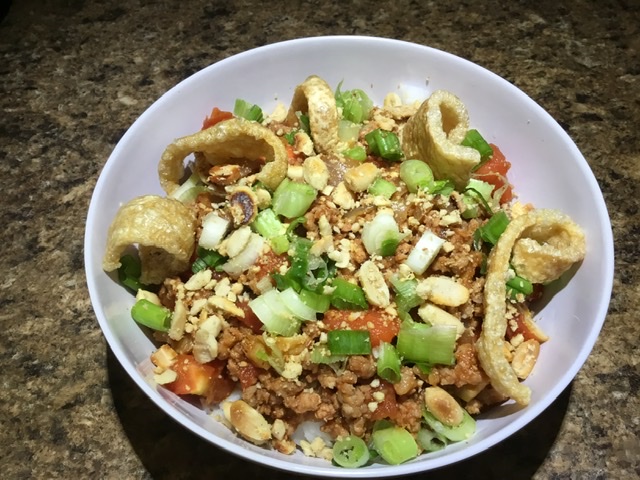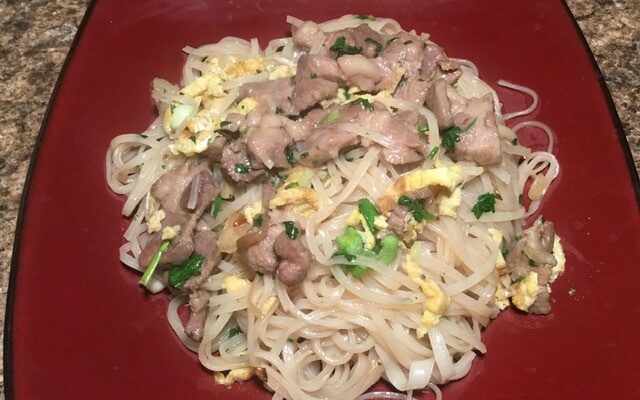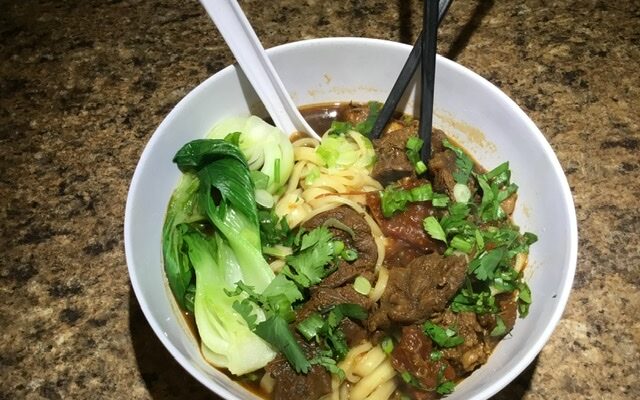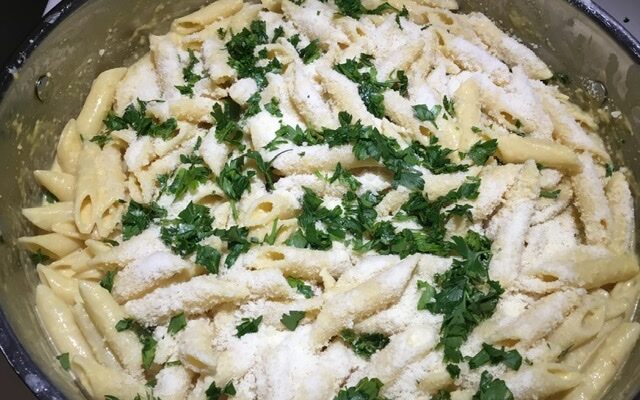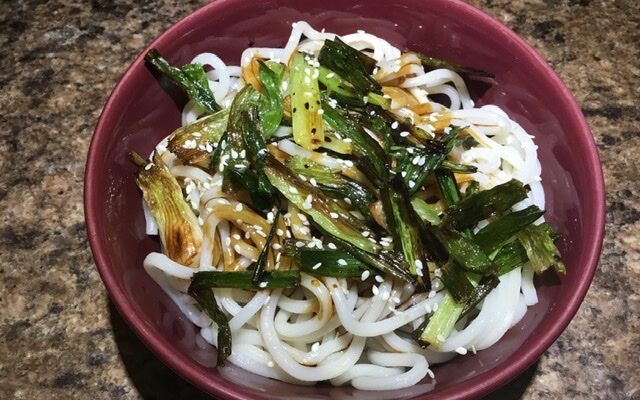Tag: noodles
Kow Piek Sen (Chicken Soup with Pork Meatballs, Quail Eggs, and Rice Macaroni)
Kow Piek Sen (Chicken Soup with Pork Meatballs, Quail Eggs, and Rice Macaroni)
Kow piek sen is a great example of Laotian comfort food. This is more than just a chicken soup, my friends. Inside of the large pot I made contains pork meatballs, quail eggs, and rice macaroni with a ton of green onions and cilantro; and a ton of chicken. The soup is garnished with more green onions and cilantro, plus fried garlic. I kinda wish I made a double batch.There are a few approaches you can take when making this soup. You can use either a whole chicken or chicken pieces. I had a few bone-in chicken breasts and backs in my freezer. Do not use boneless chicken. The bones in the chicken are creating the stock. Once the chicken is cooked through, remove from the pot and pull off the meat. Place the rest of the ingredients into the pot along with the chicken. The pork meatballs are specifically Asian style. You can find them in the freezer section of every Asian market.You can find rice macaroni at just about every grocery grocery store nowadays. If you are feeding a group of people and not planning to have leftovers, you can place the dry macaroni into the pot once the chicken has been removed. Cook the macaroni until it is tender before adding the rest of the ingredients in. If you are like me and planning to have leftovers for a couple of meals, prepare the macaroni separately. Place the macaroni in the bottom of a bowl and ladle the soup over. If you don’t do this and leave the macaroni in the pot of soup for leftovers, they become mush and will ruin the soup.
Servings: 4
Ingredients
- 3 lbs whole chicken or chicken pieces
- 1 large onion diced
- 1 stalk lemongrass smashed; tied in a knot
- 10 cups water
- 1 tsp salt
- 12 oz pork meatball sliced in half
- 1 can quail eggs
- 4 green onions
- 1/2 cup cilantro chopped
- 2 tsp chili oil
- 2 tsp fish sauce
- 2 tsp light soy sauce
- 1 tsp sugar
- 1 1/2 cups dry rice macaroni prepared according to package directions
Garnish
- green onions chopped
- cilantro chopped
- fried garlic
Instructions
- Place the chicken, onions, lemongrass, and salt in a pot with 10 cups of water. Bring to a boil. Reduce the heat to medium and simmer for 45 minutes until the chicken is cooked completely through.
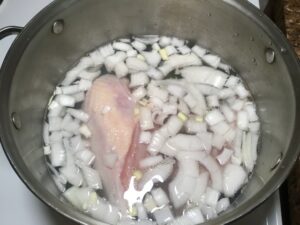
- Remove the lemongrass and chicken from the pot. Let the chicken cool enough to handle. Remove the meat from the bones and chop.
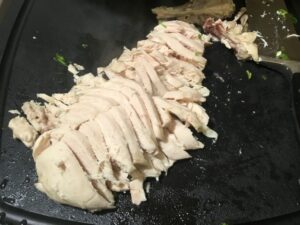
- Place the chopped chicken into the pot along with the pork meatballs, quail eggs, green onion, cilantro, fish sauce, soy sauce, chili oil, and sugar. Simmer for 15 minutes.

- Season with salt to taste.
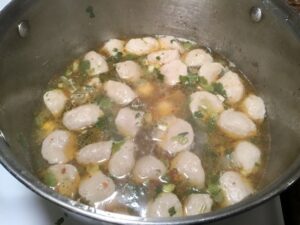
Assembly
- Place 3/4 cup of the cooked rice macaroni in the bottom of a large soup bowl.
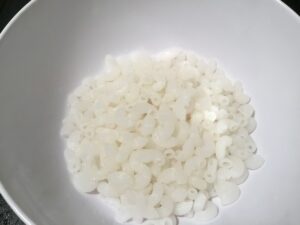
- Ladle the soup over the rice macaroni. Garnish with green onions, cilantro, and fried garlic.
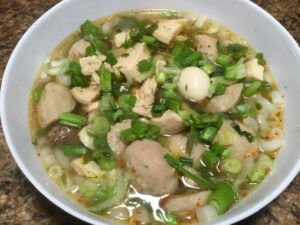
Pork Tonkatsu Ramen
Pork Tonkatsu Ramen
Pork tonkatsu ramen is my favorite of all the ramen varieties. It is known for it’s creamy rich white broth and slices of chasu pork that dwell inside of this bowl of perfection. The ramen is also topped with a ramen egg, bean sprouts, black fungus, and lots of green onions. If you want to go all out with your ramen like in this recipe, you are going to have to plan out 2 days to really make this ramen right. Making the chasu pork and the ramen egg is a 2 day process; both of which are included at the bottom of the recipe. The rest of the ramen ingredients and assembly will only take 25 minutes to prepare.
Ingredients
Broth
- 2 cups chicken stock
- 2 cups dashi
- 2 cups unsweetened soy milk or cashew, almond, or oat milk
- 1/4 cup lard
Tonkatsu Ramen
- 1 portion ramen noodles
- 3 tbsp tare sauce
- 1 green onion chopped
- 1/2 cup bean sprouts
- 3 dried black fungus rehydrated
- 3 slices chasu pork
- 1 ramen egg sliced in half
Instructions
Broth
- Bring the chicken stock and lard to a boil.
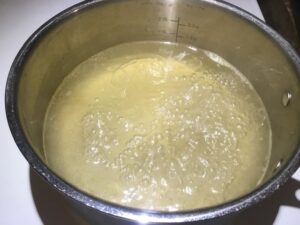
- Add in the dashi and soy milk. Bring to a simmer over medium heat.
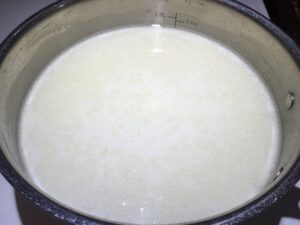
Prepping Tonkatsu Ramen Ingredients
- Bring a pot of water to boil. Blanch the black fungus for 1 minute. Scoop out and set aside.

- Blanch the bean sprouts for 1 minute. Set aside.

- Place the ramen noodles into the boiling water and cook according to the package directions. Set aside.

- Thinly slice a few pieces of the chasu pork.

- Sear the pork in a sauté pan for a minute a side over high heat. Set aside.

Tonkatsu Ramen Assembly
- Place the tare sauce in the bottom of a large ramen bowl.

- Ladle 1 1/2 cups of the broth into the bowl.
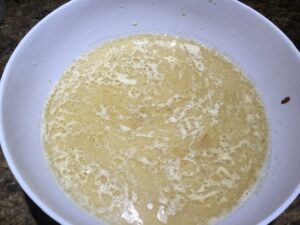
- Add the noodles and toss in the broth.
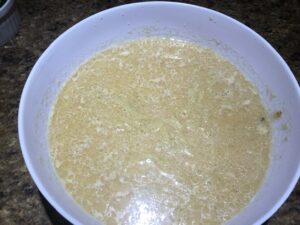
- Top with the chasu pork, ramen egg, black fungus, bean spouts, and green onions.

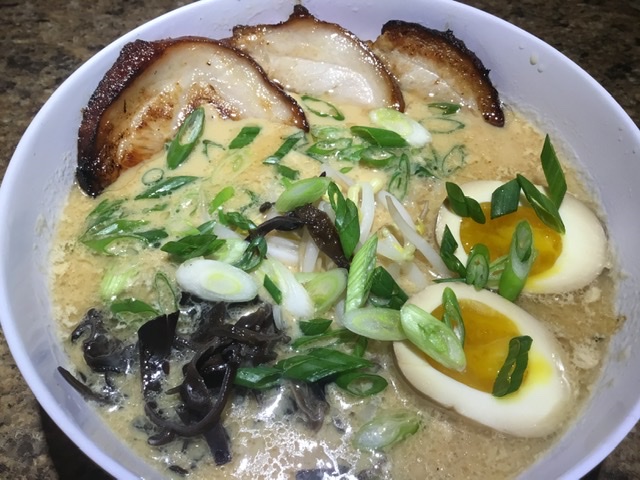
Ramen Chasu Pork
Tonkatsu ramen is my absolute favorite of all the varieties of ramen that are out there. The pork belly is my favorite part of the tonkatsu. The outer skin is crispy while the center of the pork belly rainbow is butter tender. Yes, my butter is tender.While there are many steps to make the chasu pork, it is still fairly easy to make. You can use skin-on or skinless pork belly. There is no wrong. I was only able to get skinless, so that’s what we’re going with. You will need at least a 4lb piece of pork belly. It does sound like a lot, but it is going to shrink almost by half after the braising. Place the belly fat side down and roll it up tight. Using butcher’s twine, tie the very center of the roll to hold it in place. Then tie 4 more ties around the belly on each side of the center tie; about every 1” or so.To cook the pork belly, sear it on all sides in a large Dutch oven. Pour in soy sauce, mirin, sake, sugar, ginger, garlic, and green onions. Bring it to a boil, uncovered. Then place a cover on the pot. Simmer for 90 minutes, turning the belly every 20 minutes to evenly flavor the chasu pork. Reduce the heat to medium low and simmer for an additional 30 minutes. Remove the belly from the pot. Let cool completely. Strain out the ginger, garlic, and green onions from the sauce and discard. Place the chasu pork in a gallon sized storage bag with 1 cup of the strained sauce. Refrigerate for 1 day before slicing. This step can not be skipped. This will allow the pork to keep it’s shape when sliced. Use the rest of the sauce as the tare sauce for your ramen. Tare sauce adds another dimension of flavor to your tonkatsu ramen.Chasu pork is also great to use in gua bao pork buns.
Equipment
- Butchers Twine
Ingredients
- 4 lb pork belly
- 1 cup sugar
- 1 1/2 cups soy sauce
- 1 1/2 cups mirin
- 1 1/2 cups sake
- 1/4 lb ginger sliced in half
- 2 heads garlic sliced in half
- 6 green onions
- 1 tbsp vegetable oil
Instructions
- Place your pork belly skin side down on a cutting board.

- Roll up your pork belly tight. Using butcher’s twine, tie up the pork belly in the very center of the roll.
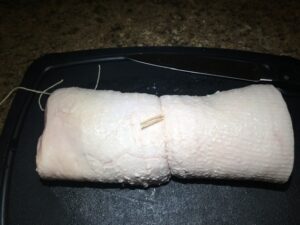
- Tie up the pork belly every inch or so; at least 4 times on each side of the center tie.
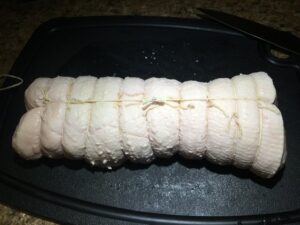
- Heat up the cooking oil in a Dutch oven over medium high heat. Brown the tied up pork belly on all sides for 10-12 minutes in total.
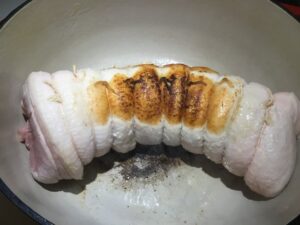
- Mix together the sugar, soy sauce, mirin, and sake. Pour into the Dutch oven. Add in the ginger, garlic, and green onions. Bring to a boil uncovered.
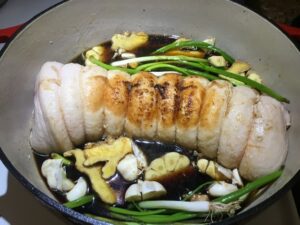
- Place a cover on the Dutch oven. Simmer for 90 minutes, turning every 20 minutes in the sauce.
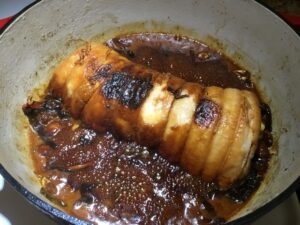
- Refuce the heat to medium low and continue simmering for 30 more minutes.
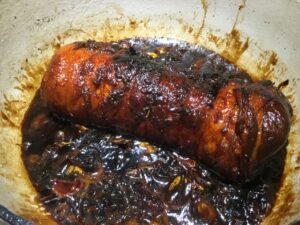
- Take the pork belly out of the pot and let cool.

- Strain the sauce of the ginger, garlic, and green onions.
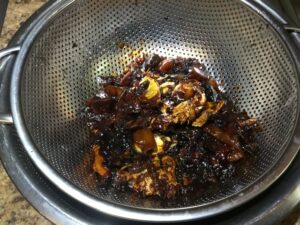
- Place the pork belly in a gallon sized storage bag with 1 cup of the strained sauce. Place in the refrigerator for 24 hours before use.

- Save the rest of the sauce. This is now the tare sauce for the ramen.
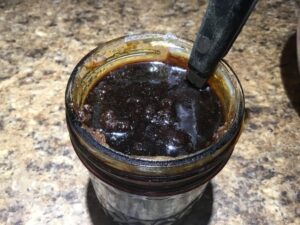
Ramen Egg
Every bowl of ramen requires a nice marinated ramen egg. They couldn’t be easier to make. There really isn’t any wrong to how done you want the yolks in your egg. They can be cooked all the way through, or slightly runny. It is all about the marinade. Bring a pot of water to a boil. Drop in the eggs. Cover. Turn off the heat. For a runny yolk, let sit for 7 minutes. For more of a hard boiled yolk, let sit for 9 minutes. Shock in an ice bath, then peel the eggs. The eggs will marinate in a mix of soy sauce, mirin, sake, and white pepper for an absolute minimum of 4 hours. Letting your eggs marinate for at least a day will give the eggs a stronger flavor, which is really what you want. You can even marinate the eggs for up to 2 days. When ready to serve in your ramen, slice in half and place on top of your bowl.
Ingredients
- 4 large eggs
- 3 tbsp soy sauce
- 2 tbsp mirin
- 1 tbsp sake
- pinch white pepper
Instructions
- Bring a pot of water to a boil. Carefully drop in the eggs. Place a cover on the pot. Let sit for 7 minutes.

- Shock the eggs in an ice water bath. Let completely cool for 10 minutes.

- Mix together the soy sauce, mirin, sake, and white pepper.

- Peel the eggs. Marinate the eggs in a ziplock bag for 1 day. Casually flip the bag every few hours throughout the day.

Shan Noodles
Shan Noodles
While this looks just like a spaghetti sauce over rice noodles, the flavors are very different. Shan noodles is like a Burmese version of a bolognese. The addition of chili powder(I used Kashmiri), ginger, soy sauce, and the garnishes(peanuts, green onions, and pork rinds) compliments the hearty tomato sauce. Shan noodles are typically served with pickled mustard greens and chickpea tofu.
Servings: 4
Ingredients
- 1/4 cup vegetable oil
- 1 lb ground pork or chicken
- 1 large onion chopped
- 6 garlic cloves minced
- 2 tbsp ginger minced
- 2 tbsp chili powder
- 3 large tomatoes chopped
- 1 tbsp tomato paste
- 3 tbsp soy sauce
- 2 tbsp sugar
- 1 lb dry rice noodles prepared according to package
Garnish
- peanuts crushed
- green onions chopped
- pork rinds
Instructions
- Heat up vegetable oil in a large saucepan over medium high heat. Sauté the onions, garlic, and ginger for 8 minutes.
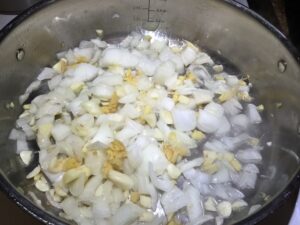
- Add in the chili powder and fry for another minute.
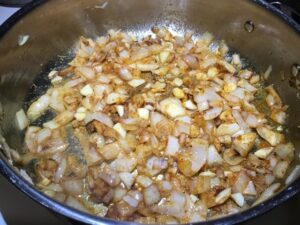
- Add in the ground meat. Cook for 8 minutes until cooked through.
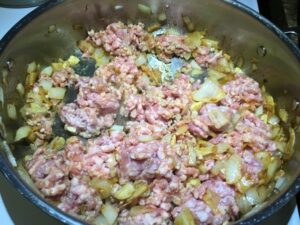
- Stir in the tomatoes, tomato paste, soy sauce, and sugar.
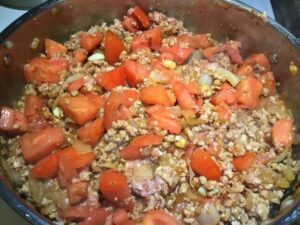
- Turn the heat to medium. Simmer for 15 minutes.

